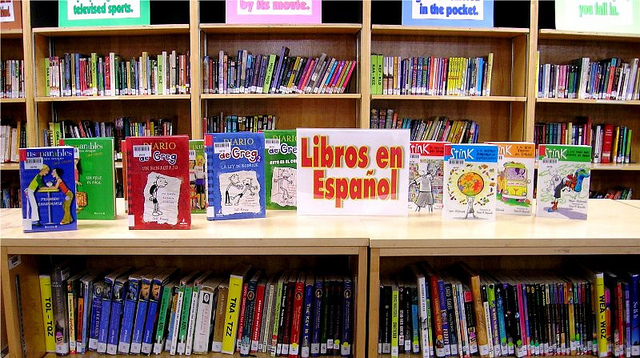A couple of years ago, I had the pleasure of attending the National Latino Children’s Literature Conference, held every two years in Tuscaloosa, Alabama. The conference is organized by Dr. Jamie Campbell Naidoo, an expert on the portrayal of Latino cultures in children’s books and media (and recently consulted by Sesame Street as they focus on their Latino storylines!).
Dr. Naidoo had organized an event at his local library as part of the conference to celebrate El día de los niños/El día de los libros (Children’s Day/Book Day). We were curious to see what attendance would be like because even though the city had a growing Spanish-speaking population, the library hadn’t had much success engaging its Latino families.
As the storytelling program began that evening and Monica Brown and Rafael Lopez took their places to read from My Name is Celia: The Life of Celiz Cruz/Me llamo Celia: La vida de Celia Cruz, all of the chairs were filled. The area reserved for children was overflowing into the aisles and the families stayed late into the night to have their books signed by the visiting author and illustrator. The librarians were amazed at the turnout, and they told our group that they had never had so many Latino families in the library at the same time before.
What was the secret to the event’s success? While Dr. Naidoo’s efforts in promoting the event throughout the community made an important difference, the true secret to his success was something even more fundamental: his belief that Latino, bilingual, and immigrant families have a place at the library and his understanding they want to use the public library – as long as they feel welcome and know what the library has to offer!
What does the library offer bilingual families?
The library is a treasure trove for bilingual families. Public libraries can be a resource for:
- Books for children and adults in foreign languages
- Bilingual children’s books
- Music and movies in multiple languages
- Books, music, movies, and software that can be used to support learning English or a foreign language
- Computer programs and Internet resources
- Bilingual programming, such as story time or a teen book club
Helping bilingual families learn about these great resources is an important step in welcoming them into the library. Immigrant families may not come from a country that has a strong public library system, or they may assume that the library is only for U.S. citizens. However, a little information can go a long way!
One way to inform these families about the library is through your child’s school. Talk with your school librarian about inviting a public librarian to the school to offer an introduction to the library. Provide families with the opportunity to sign up for library cards, ask questions, and learn about the wide variety of resources, computer facilities, and programming options available. Ask the librarian to explain how to sign up for a library card and to discuss what kinds of identification are accepted. Suggest a family field trip to the library, and be sure that any bilingual materials that the library has are highlighted on the tour.
What if my library doesn’t have any bilingual materials?
If you’re up for it, you may want to try a little bit of grassroots advocacy. Start by asking your librarian what the existing collection and programming schedule has to offer – you may be surprised! If the library doesn’t have any bilingual offerings, ask the librarian what steps would be needed in order to purchase more bilingual materials or add bilingual programming.
You may find that a lack of materials is not the result of a lack of interest on the part of the librarians – obstacles such as budget cuts, reluctance to invest in foreign language materials (especially in communities where tensions around immigration are running high), or skepticism that immigrant or bilingual families are interested in coming to the library can play a big role in library management decisions.
If you encounter these issues, ask the librarians if there are ways that you can be helpful or small steps that the community can take to start addressing these issues. You may find, for example, that parents who have enrolled their children in dual-language programs are experienced and effective advocates for bilingual programming who can assist the librarian with messaging, advocacy, and grant proposals.
In the meantime, keep track of the ways you are using bilingual materials at home. What are the different ways in which you and your kids read bilingual children’s books together? Are you attending special story times in different languages at the library? The more examples and ideas you have, the better prepared you’ll be to help other parents make the most of what their public library has to offer — and to help your library understand the value of supporting bilingual families in as many ways as possible.
Booklist bonus: If thinking about the library has gotten you in the mood to curl up with a good story, check out Colorín Colorado’s Fun at the Library booklist (also available in Spanish) — it will definitely hit the spot!
{Photo by: Enokson}
DON’T FORGET TO ENTER OUR CELEBRATING BILINGUAL READERS CONTEST FOR YOUR CHANCE TO WIN OVER $300 WORTH OF BILINGUAL/SPANISH BOOKS AND A KINDLE FIRE!


 Lydia Breiseth is Manager of Colorín Colorado, a bilingual website serving educators and families of English language learners and based at public broadcasting station WETA. Ms. Breiseth has published articles on a variety of educational and literacy blogs on behalf of Colorín Colorado, including FirstBook, Bookjoy from Pat Mora, the Latin Baby Book Club, Larry Ferlazzo’s ESL Websites of the Day, and the blog affiliated with Speaking in Tongues, a 2010 documentary about dual-language education.
Lydia Breiseth is Manager of Colorín Colorado, a bilingual website serving educators and families of English language learners and based at public broadcasting station WETA. Ms. Breiseth has published articles on a variety of educational and literacy blogs on behalf of Colorín Colorado, including FirstBook, Bookjoy from Pat Mora, the Latin Baby Book Club, Larry Ferlazzo’s ESL Websites of the Day, and the blog affiliated with Speaking in Tongues, a 2010 documentary about dual-language education.

Thank you for this post! I love your tips and shared them via a link in my post this morning: http://www.iteachduallanguage.blogspot.com/2012/04/do-you-love-your-biblioteca.html
You and your family can also have a lot of
fun relocating at Phoenix, especially if you ike arts. This has led to a spurt in the demand for reliable LCL
consolidators to serve the requirements of small and medium-sized businesses and manufacturers.
Removals can be a tough thing for adults, so for children they are definitely very
difficult to deal with. Aregional relocation covers a radius of all around sixty to one hundred km of atown.
Reliability aside from choosing an affordable and well known shipping company like LTV International Removals,
it is also best to review their reliability.